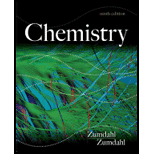
(a)
Interpretation:
Drawing the molecular-level pictures of strong electrolytes when its breaks up into component ions upon dissolving in water.
Concept Introduction:
Strong electrolyte totally dissociates in a solution. These ions are good conductors of emotional current in the solution.
(a)
Answer to Problem 23E
The dissociation of the given strong electrolyte is,
Explanation of Solution
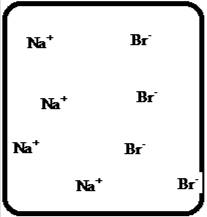
Figure 1
Let us consider the above molecular-level pictures of
number of
(b)
Interpretation:
Drawing the molecular-level pictures of strong electrolytes when its breaks up into component ions upon dissolving in water.
Concept Introduction:
Strong electrolyte totally dissociates in a solution. These ions are good conductors of emotional current in the solution.
(b)
Answer to Problem 23E
The dissociation of the given strong electrolyte is,.
Explanation of Solution
To draw the molecular-level pictures of
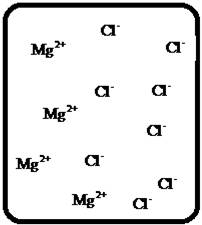
Figure 2
Let us consider the above molecular-level pictures of
number of
(c)
Interpretation:
Drawing the molecular-level pictures of strong electrolytes when its breaks up into component ions upon dissolving in water.
Concept Introduction:
Strong electrolyte totally dissociates in a solution. These ions are good conductors of emotional current in the solution.
(c)
Answer to Problem 23E
The dissociation of the given strong electrolyte is,
Explanation of Solution
To draw the molecular-level pictures of
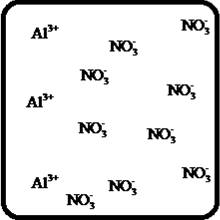
Figure 3
Let us consider the above molecular-level pictures of
number of
should show equal
number of
(d)
Interpretation:
Drawing the molecular-level pictures of strong electrolytes when its breaks up into component ions upon dissolving in water.
Concept Introduction:
Strong electrolyte totally dissociates in a solution. These ions are good conductors of emotional current in the solution.
(d)
Answer to Problem 23E
The dissociation of the given strong electrolyte is,
Explanation of Solution
To draw the molecular-level pictures of
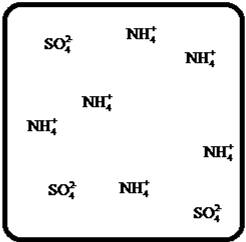
Figure 4
Let us consider the above molecular-level pictures of
number of
(e)
Interpretation:
Drawing the molecular-level pictures of strong electrolytes when its breaks up into component ions upon dissolving in water.
Concept Introduction:
Strong electrolyte totally dissociates in a solution. These ions are good conductors of emotional current in the solution.
(e)
Answer to Problem 23E
The dissociation of the given strong electrolyte is,
Explanation of Solution
To draw the molecular-level pictures of
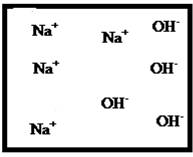
Figure 5
Let us consider the above molecular-level pictures of
Number of
(f)
Interpretation:
Drawing the molecular-level pictures of strong electrolytes when its breaks up into component ions upon dissolving in water.
Concept Introduction:
Strong electrolyte totally dissociates in a solution. These ions are good conductors of emotional current in the solution.
(f)
Answer to Problem 23E
The dissociation of the given strong electrolyte is,
Explanation of Solution
To draw the molecular-level pictures of
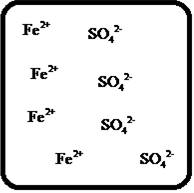
Figure 6
Let us consider the above molecular-level pictures of
number of
(g)
Interpretation:
Drawing the molecular-level pictures of strong electrolytes when its breaks up into component ions upon dissolving in water.
Concept Introduction:
Strong electrolyte totally dissociates in a solution. These ions are good conductors of emotional current in the solution.
(g)
Answer to Problem 23E
The dissociation of the given strong electrolyte is,
Explanation of Solution
To draw the molecular-level pictures of
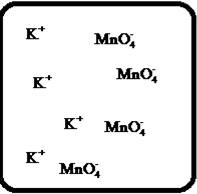
Figure 7
Let us consider the above molecular-level pictures of
number of
(h)
Interpretation:
Drawing the molecular-level pictures of strong electrolytes when its breaks up into component ions upon dissolving in water.
Concept Introduction:
Strong electrolyte totally dissociates in a solution. These ions are good conductors of emotional current in the solution.
(h)
Answer to Problem 23E
The dissociation of the given strong electrolyte is,
Explanation of Solution
To draw the molecular-level pictures of
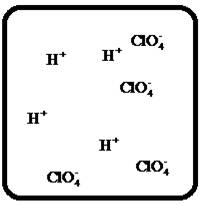
Figure 8
Let us consider the above molecular-level pictures of
number of
(i)
Interpretation:
Drawing the molecular-level pictures of strong electrolytes when its breaks up into component ions upon dissolving in water.
Concept Introduction:
Strong electrolyte totally dissociates in a solution. These ions are good conductors of emotional current in the solution.
(i)
Answer to Problem 23E
The dissociation of the given strong electrolyte is,
Explanation of Solution
To draw the molecular-level pictures of
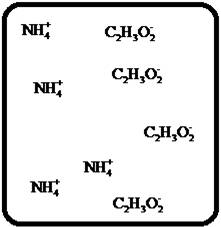
Figure 9
Let us consider the above molecular-level pictures of
Number of
Want to see more full solutions like this?
Chapter 4 Solutions
Chemistry
- Select/ Match the correct letter from the image below for the IUPAC names given below: A B C D 3 E F G H K L Part 1. 4-methylheptane For example.mmmm Answer Letter H _for part 1 Part 2. 2,4-dimethylhexane Part 3. 2,3-dimethylpentane Part 4. 2,2-dimethylhexane Part 5. 2-ethyl-1,1,3,3-tetramethylcyclopentane Part 6. 3-ethyl-2-methylpentanearrow_forwardCan u show the process as to how to get these?arrow_forwardSketch the expected 'H NMR spectra for the following compound. Label all of the H's in the structure and the corresponding signal for the spectra you sketch. Make sure you include the integration value and the splitting pattern for each signal Indicate how many signals you would expect in the 13C NMRarrow_forward
- Use IUPAC naming rules to name the following hydrocarbon compounds: CH2-CH3 | a) CH-CH-CH2-CH-CH-CH3 b) | CH2 CH3 | CH3 CH3 \ / C=C H 1 H CH2-CH3 c) d) CH=C-CH3 e) CH3-CH2-CH2-CH=CH-CH3 f) CH2=CH-CH2-CH=CH-CH3 g) CH3-CH2-C = C-CH2-CH3 h)arrow_forwardQ5 Name the following : a. b. C. d. e.arrow_forward25. Predict the major product of the following reaction. 1 equivalent of each of the starting materials was used. H₂C CH3 CH3 H3C H3C H3C. CH2 + H3C. heat CH3 CH H.C. CH3 H.C H.C CH3 CH CH3 CH3 A B C Earrow_forward
- Find chemical structures based on the below information. a) Chemical formula C6H8O Compound is aromatic plus has two 1H NMR peaks that integrated for 3 each that are singlets (it could have more peaks in the 1H NMR b) Chemical Formula: C6H100 Compounds is conjugated 'H NMR has a signal that integrates for 6 and is a doublet IR spectra has a signal at 1730 cm-1arrow_forwardJaslev Propose a synthesis of the following starting from benzene and any other reagents and chemicals. No mechanisms are required. Indicate the condition for each step plus the major product for each step. More than two steps are required. Step 1 Step 2 مہد Brarrow_forwardPart C: The line formula for another branched alkane is shown below. i. In the IUPAC system what is the root or base name of this compound? ii. How many alkyl substituents are attached to the longest chain? iii. Give the IUPAC name for this compound.arrow_forward
- Part D: Draw the Structural Formula for 4-ethyl-2-methylhexane Part E. Draw the Structural Formula for 1-chloro-3,3-diethylpentane (Chloro = Cl)arrow_forwardPart B: The line formula for a branched alkane is shown below. a. What is the molecular formula of this compound? Number of C. Number of H b. How many carbon atoms are in the longest chain? c. How many alkyl substituents are attached to this chain?arrow_forward24. What is the major product for the following reaction? Mg J. H.C CH H,C- Then H₂O OH Br C HO E HO H.C CH H.C- CH₂ CH₂ All of these are possiblearrow_forward
 Introductory Chemistry: A FoundationChemistryISBN:9781337399425Author:Steven S. Zumdahl, Donald J. DeCostePublisher:Cengage Learning
Introductory Chemistry: A FoundationChemistryISBN:9781337399425Author:Steven S. Zumdahl, Donald J. DeCostePublisher:Cengage Learning ChemistryChemistryISBN:9781305957404Author:Steven S. Zumdahl, Susan A. Zumdahl, Donald J. DeCostePublisher:Cengage Learning
ChemistryChemistryISBN:9781305957404Author:Steven S. Zumdahl, Susan A. Zumdahl, Donald J. DeCostePublisher:Cengage Learning Chemistry: An Atoms First ApproachChemistryISBN:9781305079243Author:Steven S. Zumdahl, Susan A. ZumdahlPublisher:Cengage Learning
Chemistry: An Atoms First ApproachChemistryISBN:9781305079243Author:Steven S. Zumdahl, Susan A. ZumdahlPublisher:Cengage Learning
 Chemistry: The Molecular ScienceChemistryISBN:9781285199047Author:John W. Moore, Conrad L. StanitskiPublisher:Cengage Learning
Chemistry: The Molecular ScienceChemistryISBN:9781285199047Author:John W. Moore, Conrad L. StanitskiPublisher:Cengage Learning Chemistry & Chemical ReactivityChemistryISBN:9781337399074Author:John C. Kotz, Paul M. Treichel, John Townsend, David TreichelPublisher:Cengage Learning
Chemistry & Chemical ReactivityChemistryISBN:9781337399074Author:John C. Kotz, Paul M. Treichel, John Townsend, David TreichelPublisher:Cengage Learning





